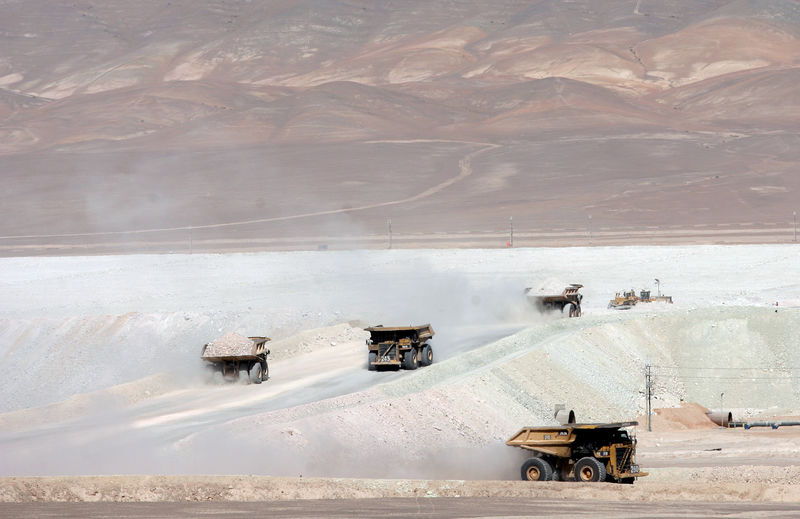By Eric Onstad and Maiya Keidan
LONDON (Reuters) - New commodity funds springing up to bet on inflation are battling for buy-in from investors still wary of past underperformance and a raft of big-name closures in the sector.
At least three commodity-focused hedge funds launched in the first six months of this year, compared with two new funds for the whole of 2017, data from industry tracker Preqin found.
But institutional investors are still cautious about returning cash to the asset class after years of lacklustre returns.
"We've been seeing lots of investors. The issue we've been having is they've already de-allocated from the asset class and we're having to convince them to get back in," said Eric Armitage, chief investment officer of East Alpha in London. Investors dipping back into the sector are largely concerned about inflation eroding their current portfolios, fund managers say.
Commodities have seen hedge funds worth several billions of dollars shut down in recent years after losses and investor outflows, including big names such as Chris Levett's Clive Capital, Andy Hall's Astenbeck Capital and, most recently, Jamison Capital.
"We've been lucky because we've been with the big survivors but it's not been a great place in general," said a London-based hedge fund investor.
Despite investor caution, at least three further new launches are planned this year, investors told Reuters.
Oil specialist Westbeck Capital is planning to launch an electric vehicle metals fund this autumn with $100 million (£77.12 million) in assets, which will invest in 30-50 stocks, while new firm KLI Asset Management will launch a strategy to identify commodity trends and market dislocations.
East Alpha, a computer-driven commodity strategy that launched in January, has $100 million of assets under management (AUM) and aims to build to $1 billion by the end of next year.
The fund has gained 7.66 percent so far this year.
Investors may also be galvanised by the number of liquidations falling dramatically. After 26 commodities hedge funds shut down in 2017, the pace has slowed to six so far in 2018, according to Preqin data.
The Thomson Reuters/Core Commodity CRB index (TRCCRBTR) soared 450 percent from early 1999 until hitting a peak in July 2008 as investors piled into the sector on the back of China's thirst for raw materials.
The index has had a rockier ride since the global financial crisis, while a glut of supplies also weighed on prices. It now sits at less than half the level of its peak, although it has rebounded 27 percent since the start of 2016.
(Graphic: CRB Commodities Index vs MSCI World Equities Index - https://reut.rs/2O4SIZc)
INFLATION HEDGE?
As steady global growth raises the prospect of inflation, hedge funds are more broadly moving back into the commodity space.
So-called 'macro' hedge funds, which bet on global economies using a range of instruments, are among those involved.
"What we did see was that some macro managers view commodities less so as a proxy for equities to play a growth story, but more to gain exposure to inflation-sensitive instruments," said Jens Foehrenbach, chief investment officer of Man Group's (L:EMG) hedge fund investing unit.
Another investor said there had been interest in metals for a few quarters, related to optimism on global growth.
Terence Brennan, portfolio manager of New York-based Lazard's Global Asset Management's Commodities Fund that launched last month, said the actively-managed, long-only fund is drawing interest from pension funds.
"Investors are looking around since as you come out of QE (quantitative easing), if you're holding low interest rate paper, it tends go down in value and commodities provide diversification against that risk."
Lazard has $252 billion under management and is an indirect unit of Lazard Ltd (N:LAZ).
"We have seen an increased pickup in interest in commodities, partly driven by the inflation hedging properties as well as the move into positive roll yield for oil," said Nicholas Johnson, portfolio manager for commodities at Pimco in Newport Beach, California.
Pimco's GIS Commodity Real Return fund has $638 million in assets and is up 2.2 percent over the past 12 months but has shed 6.85 percent over five years.
(Graphic: CPI Inflation for the G4 - https://reut.rs/2Mfpg2l)
ROLL YIELDS
Investors have welcomed the "roll yield" in oil and some other commodities, where nearby futures contracts are at a premium to distant ones. That means that when investors roll their positions each month they receive an automatic gain.
But that can backfire when the opposite structure is in place, which contributed to poor returns in the past.
Brennan, who brought his team to Lazard from Deutsche Asset Management in 2016, said the positive roll yield in WTI oil futures had recently hovered around 7-12 percent.
To avoid the pitfalls of previous commodity funds that got stung by negative roll yields, the Lazard fund will sometimes invest in commodity-linked stocks instead of futures.
The commodities sector generally has a low correlation with other asset classes, offering diversification, although events such as the global financial crisis can overwhelm the supply/demand fundamentals that should dictate commodity prices. That trend has also been seen recently as trade tensions depress both stocks and commodities.
The 30-day correlation between the CRB commodity index and the MSCI world equities index (MIWD00000PUS) is down to 51 percent from a peak of 78 percent in June 2016, but has more than doubled from 20 percent in late January.
